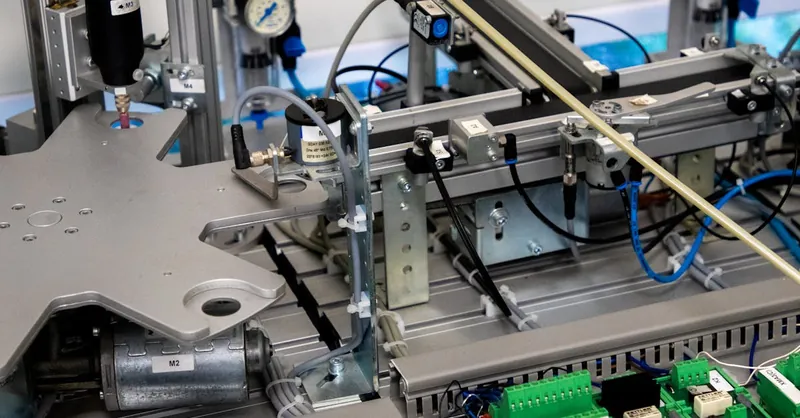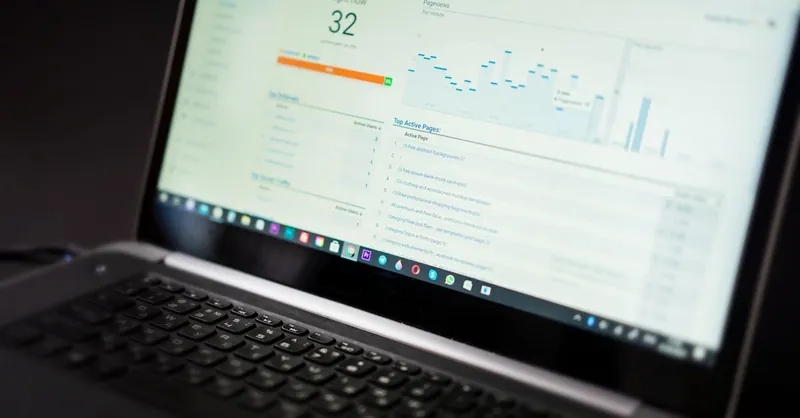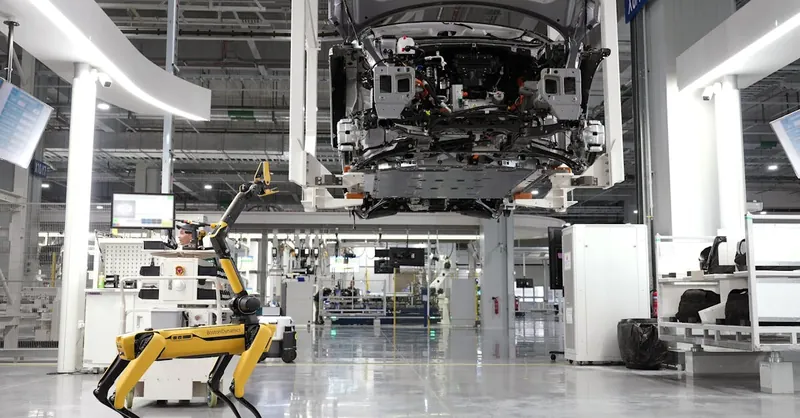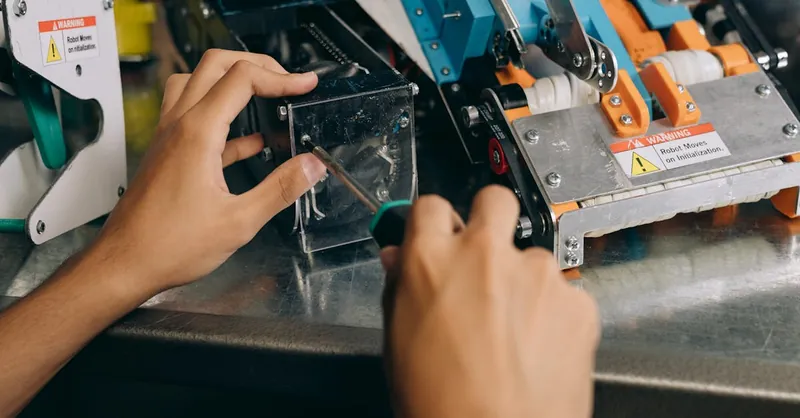Boost Workflow Efficiency Using Robotic Process Automation
Category: Productivity & Automation
Transform Your Daily Workflows with Robotic Process Automation
If you're a professional, entrepreneur, or tech enthusiast striving to elevate your daily productivity, you’ve likely encountered the challenge of repetitive, time-consuming tasks that sap your energy and focus. Perhaps you’re juggling multiple responsibilities, from managing emails and scheduling to processing data or handling customer queries. You’ve heard about Robotic Process Automation (RPA) and its potential to streamline work, but you’re unsure how to integrate it effectively into your daily routine and maximize its benefits.
This post is designed precisely for you. Whether you are new to RPA or already exploring automation opportunities, we’ll explore pragmatic ways to leverage RPA to optimize your workflows, reduce errors, and free up time for high-impact activities. Unlike generic automation advice, our approach is grounded in real-world application, helping you understand which processes to automate, how to get started, and how to scale your automation efforts profitably.
By the end of this guide, you’ll not only grasp the fundamentals of RPA but also gain actionable insights tailored to daily work scenarios, enabling you to make informed decisions. Ready to transform tedious tasks into seamless automated flows? Let’s dive into how RPA can be a game-changer for your productivity and growth.
- Transform Your Daily Workflows with Robotic Process Automation
- Understanding Robotic Process Automation: Definition and Core Concepts
- Identifying Daily Work Tasks Ideal for RPA Implementation
- Benefits of Using RPA in Daily Workflows: Accuracy, Speed, and Scalability
- Step-by-Step Guide to Selecting RPA Tools for Your Needs
- Integrating RPA with Existing Software and Systems Smoothly
- Practical Use Cases: Automating Data Entry, Email Management, and Reporting
- Overcoming Common Challenges and Mistakes in RPA Adoption
- Measuring ROI and Performance Metrics for RPA Initiatives
- Future Trends: AI-Enhanced RPA and Its Role in Workplace Productivity
- Best Practices to Maintain and Scale Your RPA Solutions Over Time
Understanding Robotic Process Automation: Definition and Core Concepts
Robotic Process Automation (RPA) refers to the use of software “robots” or bots to automate highly repetitive, rule-based tasks that are traditionally performed by humans. These bots mimic human actions by interacting with digital systems, applications, and user interfaces to execute workflows without the need for constant supervision. Unlike traditional automation, which often requires complex coding and deep integration, RPA tools are designed to be user-friendly and flexible, enabling quick deployment across various business functions.
At its core, RPA works by configuring bots to handle tasks such as data entry, invoice processing, email management, or report generation. The three fundamental concepts to understand when starting with RPA are:
- Bot Types:
- Attended Bots work alongside users, activated on demand to assist with specific real-time tasks.
-
Unattended Bots operate independently in the background, running scheduled or triggered workflows without human intervention.
-
Process Mapping: Before automation, identifying and documenting the exact steps in a process ensures efficiency and accuracy in bot development.
-
Workflow Automation: The sequence of automated actions executed by bots, ranging from simple task automation to complex multi-application integrations.
By grasping these core concepts, you can better identify which parts of your daily work are ripe for automation, thus accelerating productivity while minimizing errors and operational costs. As you move forward in integrating RPA, this foundational understanding will guide your decision-making and help unlock the full potential of automation in your professional environment.

Image courtesy of Kindel Media
Identifying Daily Work Tasks Ideal for RPA Implementation
To unlock the full productivity potential of Robotic Process Automation, the first crucial step is identifying which daily tasks are best suited for automation. Not every repetitive task warrants RPA, so focusing on the right workflows is key to achieving meaningful efficiency gains and error reduction. Generally, tasks ideal for RPA share common characteristics such as being rule-based, repetitive, high-volume, and involving structured data.
Here are the primary criteria to consider when pinpointing daily work tasks ripe for RPA:
-
Repetitiveness and Frequency: Tasks performed frequently throughout the day or week, such as processing invoices, updating spreadsheets, or responding to standard customer inquiries, are prime candidates. Automating these eliminates monotony and accelerates turnaround times.
-
Rule-Based and Structured: Tasks with clear decision rules and predictable patterns—like validating data fields, transferring information between systems, or formatting documents—allow bots to replicate human actions accurately without ambiguity.
-
High Volume and Time-Consuming: Manual activities that consume significant chunks of time, such as email triage, report generation, or data entry from multiple sources, provide substantial ROI when automated, freeing up human effort for strategic work.
-
Low Exception Rate: Processes that rarely require human judgment or intervention ensure bots operate effectively with minimal disruptions, increasing reliability and reducing error rates.
-
Multiple System Interaction: Jobs that involve moving data or initiating actions across different applications, such as CRM updates, ERP transactions, or database synchronization, benefit from the seamless integration capabilities of RPA.
Common examples of daily work tasks ideal for RPA include:
- Automating repetitive data extraction and entry
- Processing and routing standard email requests
- Generating routine reports and dashboards
- Managing calendar scheduling and meeting coordination
- Conducting system health checks and status updates
- Performing basic IT support escalations and ticket handling
By systematically analyzing your workload against these criteria, you can create a prioritized list of automation opportunities that deliver quick wins and sustainable productivity improvements. This targeted approach ensures that your RPA investments focus on the most impactful tasks, accelerating your journey toward a more efficient, technology-driven workday.

Image courtesy of EqualStock IN
Benefits of Using RPA in Daily Workflows: Accuracy, Speed, and Scalability
Implementing Robotic Process Automation (RPA) in daily workflows unlocks powerful benefits that dramatically enhance productivity and operational efficiency. One of the most significant advantages is improved accuracy. Since RPA bots strictly follow predefined rules and eliminate human errors caused by fatigue or oversight, they ensure consistent and error-free execution of repetitive tasks such as data entry, invoice processing, or report generation. This heightened precision not only reduces costly mistakes but also strengthens data integrity across your systems.
Beyond accuracy, RPA supercharges speed and efficiency by completing routine tasks at a fraction of the time it would take a human. Bots can operate 24/7 without breaks, handling high-volume workflows rapidly and freeing employees to focus on strategic, value-added activities. This accelerated task completion leads to faster turnaround times in customer service, finance operations, and administrative duties.
Moreover, scalability is a core benefit of RPA adoption. As business demands fluctuate, bots can be deployed quickly across multiple processes and systems without the need for extensive reprogramming or additional headcount. This flexibility enables organizations and professionals alike to adapt rapidly to growth or seasonal workloads while maintaining consistent output quality.
In summary, the key benefits of integrating RPA in your daily work include:
- Precision and error reduction by automating rule-based tasks
- Accelerated task execution enabling around-the-clock productivity
- Scalable automation that grows with your workload demands
- Improved compliance through standardized process adherence
- Enhanced workforce focus on creative and strategic projects
By leveraging these benefits, RPA becomes a strategic enabler that not only streamlines your daily operations but also positions your workflow architecture for sustainable growth and competitive advantage.

Image courtesy of EqualStock IN
Step-by-Step Guide to Selecting RPA Tools for Your Needs
Choosing the right Robotic Process Automation (RPA) tool is a critical step in successfully integrating automation into your daily workflows. With a growing number of RPA platforms available, each offering unique features, capabilities, and pricing models, selecting a solution that aligns perfectly with your specific needs ensures maximum return on investment and seamless adoption.
1. Define Your Automation Requirements
Before evaluating RPA vendors, clearly outline the scope and complexity of tasks you want to automate. Consider factors such as:
- Types of processes (simple data entry versus multi-application orchestration)
- Volume and frequency of tasks
- Degree of exception handling required
- Integration needs with existing systems and software
- User skill levels and IT support availability
This foundational understanding helps narrow down tools that match your business workflows and technical environment.
2. Evaluate Key Features and Capabilities
Focus on critical functionality that directly impacts your productivity gains:
- Ease of Use: Look for low-code or no-code interfaces that empower business users without deep programming knowledge.
- Bot Types Support: Verify that the tool supports both attended and unattended bots, depending on your use cases.
- Integration Flexibility: Check compatibility with multiple applications, databases, and cloud platforms to enable seamless workflow automation.
- Scalability and Performance: Confirm how easily you can scale bot deployment as automation demand grows.
- Security and Compliance: Ensure strong data protection, role-based access, and audit capabilities to meet regulatory requirements.
- Analytics and Reporting: Robust monitoring and analytics help measure automation impact and optimize processes over time.
3. Consider Vendor Reputation and Support Ecosystem
Long-term success depends on choosing a provider with a reliable track record and strong customer support:
- Research customer reviews, case studies, and industry awards to gauge vendor credibility.
- Evaluate available training resources, documentation, and community forums.
- Understand the vendor’s roadmap and commitment to product updates and innovation.
4. Trial and Pilot Testing
Whenever possible, leverage free trials or pilot programs to test the RPA tool in your live environment. This step reveals practical usability, integration smoothness, and bot performance, allowing you to validate that the platform can handle your daily automation goals before full-scale implementation.
5. Assess Pricing Models and ROI
Cost-effectiveness is essential for sustainable automation initiatives:
- Analyze pricing structures—whether per bot, per user, or enterprise licensing—and align them with your budget and expected automation volume.
- Factor in additional expenses such as training, maintenance, and potential customization.
- Calculate projected ROI based on time savings, error reduction, and productivity improvements.
By following this structured selection process, you position yourself to choose an RPA tool that not only fits your current workflows but also scales and adapts as your automation needs evolve. This strategic approach maximizes the efficiency and impact of RPA in transforming your daily work processes.

Image courtesy of ThisIsEngineering
Integrating RPA with Existing Software and Systems Smoothly
Seamless integration of Robotic Process Automation (RPA) with your existing software and systems is essential to unlock its full productivity benefits without disrupting current workflows. Achieving smooth integration involves understanding how RPA bots interact with different applications—whether on-premises or cloud-based—and ensuring that automation complements, rather than complicates, your operational environment.
Key Strategies for Effective RPA Integration
-
Leverage API-Based Integration Whenever Possible:
Many modern business applications provide APIs (Application Programming Interfaces) that enable direct communication between RPA bots and software platforms. Using APIs for integration improves reliability, speeds up automation execution, and reduces dependence on fragile UI interactions, which can break when user interfaces update. -
Utilize Screen Scraping and UI Automation Thoughtfully:
When APIs are unavailable, RPA bots can interact via screen scraping and user interface automation, mimicking human actions to navigate software. While versatile, this method requires robust exception handling and ongoing maintenance to adapt to software changes, ensuring uninterrupted automation. -
Establish Clear Data Flow and Input-Output Mapping:
Define how data moves between systems involved in the automated process. Proper mapping of inputs and outputs prevents errors and ensures seamless handoffs between bots and applications, maintaining data consistency across platforms such as CRM, ERP, databases, and email clients. -
Ensure Compatibility with IT Infrastructure and Security Policies:
Coordinate with your IT department to align RPA deployments with existing infrastructure standards, data privacy regulations, and security protocols. This collaboration prevents integration conflicts and guarantees compliance, especially when handling sensitive or regulated data. -
Incorporate Centralized Orchestration and Monitoring Tools:
Use management consoles or orchestration platforms provided by RPA vendors to schedule, monitor, and control bots across systems. Centralized oversight simplifies identifying integration bottlenecks, managing exceptions, and scaling automated workflows effectively.
By prioritizing these integration practices, you create a robust RPA ecosystem that enhances interoperability with your current software stack. This smooth integration reduces complexity, minimizes downtime risks, and accelerates automation benefits, helping you boost daily work productivity while maintaining system harmony.

Image courtesy of Ludovic Delot
Practical Use Cases: Automating Data Entry, Email Management, and Reporting
To fully harness the productivity-boosting power of Robotic Process Automation (RPA) in daily workflows, focusing on practical use cases like automating data entry, email management, and reporting reveals immediate benefits. These critical tasks are often repetitive, time-consuming, and prone to human error—making them ideal candidates for RPA-driven automation.
Automating Data Entry
Manual data entry is one of the most labor-intensive tasks professionals face, involving copying information from emails, forms, or spreadsheets into enterprise systems like CRM, ERP, or accounting software. By leveraging RPA bots to handle these rule-based, structured data transfers, you achieve:
- Faster input speeds with 24/7 operation capability
- Near-zero error rates, ensuring data accuracy and consistency
- Significant time savings, freeing staff to prioritize analytical or strategic work
RPA bots can extract data from multiple sources, validate formats automatically, and input information across different applications without human intervention, dramatically reducing processing bottlenecks.
Enhancing Email Management
Dealing with a high volume of emails—such as sorting, categorizing, replying to routine queries, or routing requests to appropriate teams—can quickly become overwhelming. RPA streamlines email workflows by:
- Automatically classifying emails based on keywords or sender
- Triggering predefined responses to standard inquiries
- Creating and updating tickets or tasks in helpdesk systems
- Scheduling follow-ups and flagging priority messages
This level of automation minimizes inbox clutter, accelerates response times, and improves customer satisfaction by ensuring timely, accurate communication—all without constant manual oversight.
Streamlining Reporting Processes
Generating reports often requires consolidating data from disparate sources, formatting, and distributing outputs consistently, which consumes valuable work hours each reporting cycle. RPA can automate these repetitive reporting tasks by:
- Extracting data from databases, Excel sheets, or cloud platforms
- Merging and formatting data into standardized templates
- Scheduling and sending reports automatically to stakeholders
- Refreshing dashboards with real-time metrics without manual updates
Automated reporting enhances reliability, reduces turnaround time, and ensures decision-makers receive updated, error-free insights on schedule.
By applying RPA to these core daily functions—data entry, email management, and reporting—professionals unlock substantial efficiency gains that directly impact productivity and operational excellence. Implementing these practical automation solutions not only simplifies your workday but also establishes a foundation for scaling RPA across other complex workflows.

Image courtesy of Kindel Media
Overcoming Common Challenges and Mistakes in RPA Adoption
While Robotic Process Automation (RPA) offers significant productivity gains, many organizations and individuals face challenges during adoption that can hinder success. Understanding these common pitfalls is essential to navigate the automation journey effectively and ensure lasting impact in your daily workflows.
Key Challenges in RPA Implementation
-
Poor Process Selection:
Many RPA initiatives stumble because automation is attempted on complex or poorly defined processes. Automating inefficient workflows without thorough process mapping leads to suboptimal results and bot failures. Focus on well-structured, rule-based tasks with minimal exceptions to maximize benefits. -
Lack of Stakeholder Buy-In:
Resistance from employees or management can stall RPA efforts. It's crucial to involve all key stakeholders early, educate teams about the benefits of automation, and demonstrate how RPA complements human roles instead of replacing them. Building a culture that embraces innovation accelerates adoption. -
Inadequate Change Management:
Introducing RPA requires clear communication, training, and support to help employees transition smoothly. Without proper change management, users may distrust or misuse automation tools, negating potential productivity gains. -
Underestimating Maintenance Needs:
RPA bots require ongoing monitoring and updates, especially when underlying software changes. Neglecting bot maintenance can cause automation breakdowns and increase manual work. Establish a robust support structure for continuous bot health checks and improvements. -
Overlooking Security and Compliance:
Automating sensitive data or critical processes without aligning to IT security policies exposes organizations to vulnerabilities and regulatory risks. Collaborate with IT and compliance teams to enforce strict access controls, data encryption, and audit trails within your RPA environment.
Avoiding Common Mistakes
- Starting Without a Pilot: Jumping straight into large-scale automation without a pilot test increases the risk of failure. Begin with small, manageable processes to validate value and fine-tune your approach.
- Ignoring User Feedback: Regularly gather input from end users to identify issues early and adapt workflows or bot behavior accordingly.
- Focusing Solely on Costs: While RPA reduces operational expenses, prioritizing cost savings over process improvement may limit innovation. Balance efficiency with quality and scalability goals.
- Skipping Documentation: Maintain comprehensive documentation of automated processes and bot configurations to facilitate troubleshooting, compliance, and future scaling.
By proactively addressing these challenges and avoiding common mistakes, you pave the way for a smoother RPA adoption journey. This strategic mindfulness not only enhances the reliability and ROI of automation but also empowers you to leverage RPA as a sustainable productivity multiplier in your daily work landscape.

Image courtesy of Mikhail Nilov
Measuring ROI and Performance Metrics for RPA Initiatives
To truly capitalize on the advantages of Robotic Process Automation (RPA) in your daily work, it’s essential to measure Return on Investment (ROI) and track performance metrics that quantify automation success. Without clear metrics, it’s challenging to justify RPA expenditures, optimize workflows, or even identify areas for improvement over time. Establishing a robust measurement framework helps demonstrate value to stakeholders, guide scaling decisions, and ensure continuous productivity gains.
Key Performance Metrics to Monitor
-
Time Savings:
Calculate the reduction in process cycle time before and after automation. By automating repetitive tasks, bots often complete workflows considerably faster than humans, delivering measurable time efficiencies critical to boosting overall productivity. -
Error Rate Reduction:
Track the decrease in manual errors caused by human fatigue or oversight. Lower error rates directly improve data accuracy, reduce rework, and enhance compliance, making it a vital performance indicator for RPA effectiveness. -
Cost Savings:
Quantify cost reductions related to decreased manual labor hours, fewer mistakes, and faster processing. Include both direct savings (e.g., labor cost reduction) and indirect savings such as improved resource allocation and faster customer response times. -
Bot Utilization and Throughput:
Measure how often bots run and the volume of transactions processed within a specific timeframe. Higher utilization rates indicate effective integration into daily workflows, while throughput reflects the scale of automation impact. -
Exception Handling and Escalations:
Monitor the frequency and type of exceptions where bots require human intervention. Identifying common exceptions guides process optimization or additional bot training to enhance automation reliability. -
Employee Productivity Gains:
Assess how freed-up employee time is redeployed to higher-value tasks, such as strategic planning or innovation. Increased engagement and job satisfaction can be secondary benefits of effective RPA deployment, contributing to organizational growth.
Calculating ROI for RPA Projects
An effective ROI calculation balances automation costs against measurable benefits. Consider the following formula for a simplified ROI estimate:
ROI (%) = [(Total Benefits - Total Costs) / Total Costs] x 100
Where:
- Total Benefits include time savings converted into labor cost reductions, error cost avoidance, and productivity improvements.
- Total Costs encompass software licensing, development, testing, bot maintenance, training, and change management expenses.
Tracking ROI regularly allows you to justify continued investment, validate the effectiveness of automated workflows, and identify opportunities to scale RPA to new areas.
By focusing on these performance metrics and ROI calculations, you can ensure your RPA initiatives deliver tangible productivity improvements, continuously evolve with organizational needs, and create a data-driven culture around automation success in daily work environments.

Image courtesy of Atlantic Ambience
Future Trends: AI-Enhanced RPA and Its Role in Workplace Productivity
As Robotic Process Automation (RPA) continues to evolve, its integration with advanced Artificial Intelligence (AI) technologies is shaping the next frontier of workplace productivity. AI-enhanced RPA combines the strengths of rule-based automation with cognitive capabilities such as natural language processing (NLP), machine learning (ML), and computer vision, enabling bots to handle more complex, unstructured, and decision-intensive tasks. This fusion is transforming traditional automation into intelligent automation, creating smarter workflows that adapt, learn, and improve over time.
How AI Enhances RPA for Smarter Automation
-
Cognitive Understanding: AI algorithms empower RPA bots to interpret and process unstructured data like emails, documents, images, and audio. This allows automation of processes previously deemed too complex, such as sentiment analysis in customer support or intelligent document processing.
-
Adaptive Decision-Making: Through machine learning models, AI-enabled bots can analyze historical data patterns and make contextual decisions, dramatically expanding RPA’s applicability beyond fixed rule-based tasks to scenarios with variability and exceptions.
-
Improved Error Handling and Exception Management: AI helps detect anomalies and predict potential process failures, enabling proactive exception handling before issues escalate, thereby enhancing workflow resilience and reliability.
-
Enhanced User Interaction: Combining RPA with conversational AI interfaces such as chatbots and virtual assistants enhances user engagement by enabling natural language commands and real-time support, streamlining communication-driven workflows.
The Impact of AI-Driven RPA on Workplace Productivity
-
Expanding Automation Scope: With AI-powered intelligence, RPA can automate knowledge work that involves judgment, reasoning, and learning, significantly increasing the volume and complexity of tasks automated.
-
Reducing Cognitive Workload: By handling routine decision-making and information analysis, AI-enhanced RPA frees employees to concentrate on strategic, creative, and interpersonal aspects of their roles.
-
Continuous Process Improvement: AI-driven insights from automations generate data that can be continuously analyzed to optimize workflows, detect inefficiencies, and recommend improvements, fostering a culture of ongoing productivity enhancement.
-
Scalability and Agility: The synergy of AI and RPA allows organizations to rapidly scale intelligent automation across departments, adapting quickly to changing business needs and delivering consistent high-quality output.
Harnessing AI-enhanced RPA is no longer a futuristic concept but a practical strategy for professionals and businesses aiming to amplify productivity, reduce operational costs, and stay competitive in a digitally driven workplace. Embracing this convergence opens new automation possibilities that extend the benefits of RPA well beyond repetitive tasks, enabling smarter, more efficient, and highly adaptive workflows tailored for the evolving demands of modern work environments.

Image courtesy of Hyundai Motor Group
Best Practices to Maintain and Scale Your RPA Solutions Over Time
Successfully implementing Robotic Process Automation (RPA) is only the beginning of your automation journey. To fully realize the benefits and ensure long-term value, it is critical to adopt best practices for maintaining and scaling your RPA solutions effectively. Without proper upkeep and systematic growth strategies, automated workflows can become fragile, outdated, or inefficient, undermining productivity gains.
Essential Maintenance Practices for Sustained RPA Performance
-
Continuous Monitoring and Bot Health Checks:
Regularly track bot performance metrics, error logs, and exception rates to identify and resolve issues proactively. Implement automated alerts and dashboards that provide real-time insights into bot activity to prevent downtime and swiftly handle disruptions. -
Version Control and Change Management:
Maintain thorough documentation of bot configurations, workflows, and integration points. Use version control systems for automation scripts, and establish formal change management protocols to safely update bots when process changes or software upgrades occur, reducing the risk of failures. -
Frequent Process Review and Optimization:
Periodically revisit automated workflows to assess their relevance and efficiency. Incorporate user feedback and performance data to refine and optimize bots, eliminating bottlenecks and adapting automations to evolving business needs. -
Robust Exception Handling Frameworks:
Enhance your RPA bots with intelligent exception handling capabilities that can gracefully manage unexpected scenarios, trigger alerts, or escalate issues to human operators. This minimizes process interruptions and maintains smooth operations.
Strategies for Scaling RPA Across Your Organization
-
Develop a Center of Excellence (CoE):
Establish a dedicated team responsible for standardizing RPA best practices, governance, and training. A CoE ensures consistent quality, accelerates deployment, and fosters innovation across multiple departments. -
Standardize Automation Frameworks:
Implement reusable components, templates, and coding standards to streamline bot development and reduce duplication of effort. Standardization facilitates quicker rollouts and easier maintenance when scaling up. -
Leverage Analytics for Informed Scaling Decisions:
Use insights from bot performance metrics and ROI measurements to identify high-impact processes suitable for automation expansion. Data-driven scaling helps prioritize resources and maximize overall productivity. -
Ensure Scalability of Infrastructure and Licensing:
Plan for scalable RPA infrastructure, including cloud-based orchestration platforms and flexible licensing models, to support increasing volumes of automated tasks without compromising performance or compliance.
By embedding these best practices to maintain and scale RPA, you create a resilient automation environment that continuously drives efficiency gains, adapts to change, and expands seamlessly across your organizational workflows. This proactive approach transforms RPA from a project into a sustainable productivity powerhouse tailored for lasting success in daily work environments.

Image courtesy of Mikhail Nilov
